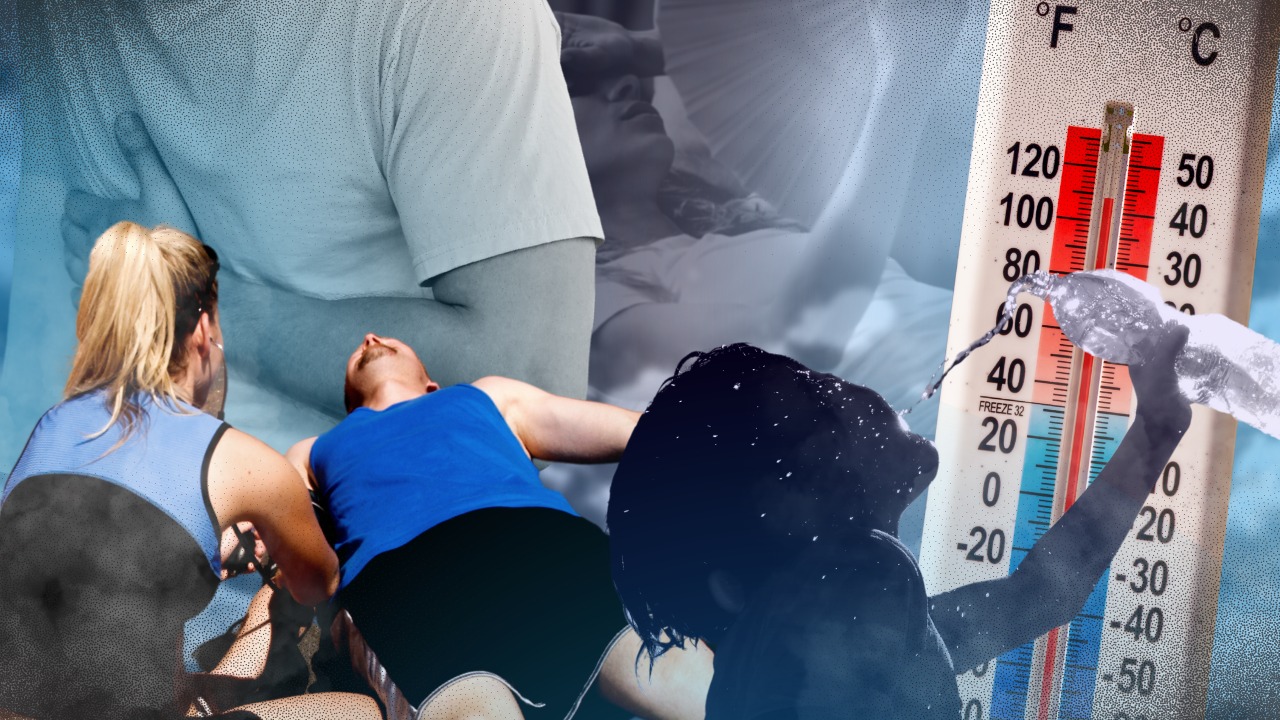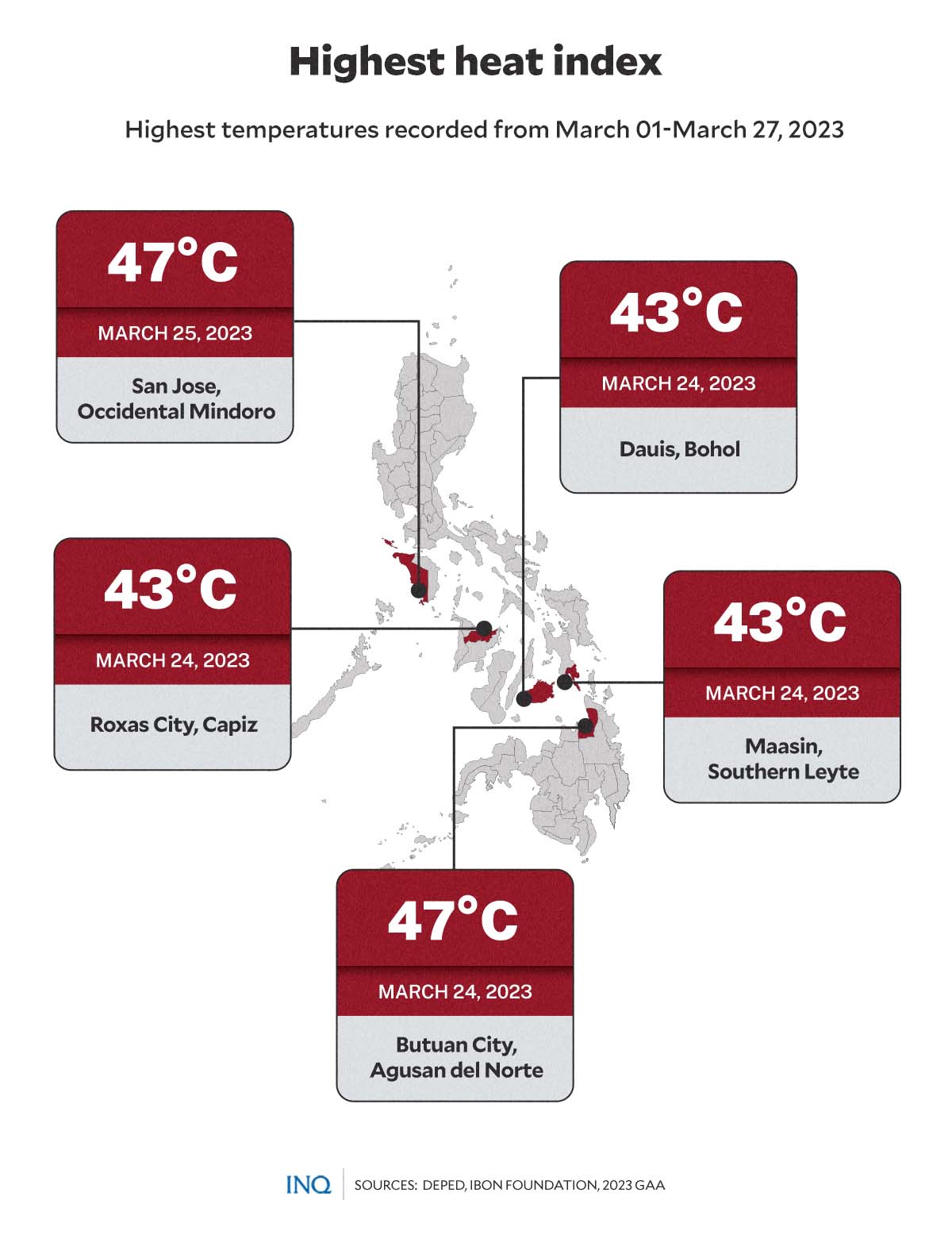MANILA, Philippines—As the country transitions from cold and rainy weather to the warm and dry season, the temperature increases again, and so do risks tied to hot and sunny days—such as its impact on people’s health and the economy.
Last week, the Philippine Atmospheric, Geophysical and Astronomical Services Administration (Pagasa) officially declared the start of the warm and dry season, which is expected to last until May.
Pagasa has also upgraded its monitoring of oceanic temperatures to an El Niño Watch, which means there is a high likelihood that the El Niño phenomenon, characterized by extreme heat and prolonged dry spells, will develop in the next six months.
READ: Pagasa issues El Niño Watch; urges public to prepare for warm, dry season
While the end of the northeast monsoon, or amihan, season signals the start of warmer temperatures across the country, more Filipinos—as well as foreign tourists—start to flock to popular beaches and other leisure destinations to beat the heat, by either dipping in the waters or soaking up cool wind.
While these activities are natural or usual among local and foreign tourists, especially amid hot weather, there are still dangers and hazards to watch out for.
Heat-related illnesses
Among the dangers of blistering temperatures are heat-related illnesses like heat cramps, heat exhaustion, sunburn, rash, and potentially fatal heatstroke.
In hot weather, the body cools itself by perspiring. “The evaporation of your sweat regulates your body temperature,” the US-based nonprofit organization Mayo Clinic explained.
However, vigorous activity during extreme heat and humid weather affects the body’s ability to cool itself efficiently. When this happens, internal heat can build up to “dangerous” levels, said Johns Hopkins Medicine.
Aside from high heat index, hot weather, and strenuous activity, Mayo Clinic likewise identified dehydration, alcohol intake, and overdressing as some causes of heat exhaustion, heat cramps, and heatstroke.
It also said that infants, children, and adults over 65 years old are at higher risk of experiencing heat-related illnesses.
“The body’s ability to regulate its temperature isn’t fully developed in the young and may be reduced by illness, medications, or other factors in older adults,” the organization said on its website.
Certain medications and obesity can also affect the body’s ability to remain hydrated and respond appropriately to heat.
What to do
According to the Department of Health (DOH), out of the common heat-related illnesses, heat stroke is the most severe form. It occurs when the body overheats and fails to cool down due to dehydration and a humid environment.
Among the emergency measures that should be taken when someone is suffering from heat stroke are:
- moving the person to a shady spot or indoors
- have them lie down with their legs elevated
- have the victim drink cool water
- remove clothing and apply cool water to the skin
- fan the person
- apply ice packs to the armpits, wrists, ankles, and groin.
READ: Explainer: How to beat ‘heatstroke’ during the summer season
The health department stressed that heat stroke is a medical emergency and that the patient should be rushed to the hospital after instituting emergency measures.
To prevent heat stroke—as well as other heat illnesses—the DOH provided the following tips:
- Limit the amount of time you spend outdoors.
- Drink plenty of water.
- Avoid tea, coffee, soda, and alcohol.
- Schedule heavy-duty activities for the beginning or end of the day when it’s cooler.
The CDC also recommended the following:
- Choose lightweight, light-colored, loose-fitting clothing.
- Cut down on exercise or strenuous activities during the heat.
- Wear sunscreen.
- Avoid hot and heavy meals.
In addition, Johns Hopkins Medicine advised the public to opt for water and sports drink and limit the intake of caffeinated tea, coffee, soda, and alcohol, as these can lead to dehydration.
It also recommended people with chronic conditions to talk with their healthcare provider about extra precautions to protect themselves against heat stroke.
Dry spells wilt PH economy
Every year, extreme dry spells during the El Niño season do not only hurt individuals but also the economy.
In 2010, El Niño unleashed droughts that damaged rice crops in the Philippines worth around $240 million (P13 billion).
With temperatures forecast to be 2 degrees higher in the succeeding years, the Asia Development Bank in 2015 estimated that damage caused by severe dry spells could reach $700-$800 million (P38-43 billion).
A report published by the World Bank last year also found that in 2016, dry El Niño conditions—which lasted for 18 months—affected about a third of the Philippines. Over 400,000 farmers and 550,000 hectares were directly affected by El Niño–induced drought.
The report stressed that the El Niño event in 2015-2016 in the Philippines caused $327 million (P17.78 billion) in agricultural production losses.
Simulations conducted by the World Bank showed that the country’s national GDP losses during an intense El Niño event amounted to $3.3 billion (P179 billion).
“Percentage losses are larger in agriculture, where GDP falls by nearly 7 percent. Subnationally, GDP losses vary across regions within the Philippines: agricultural GDP falls by 1.9 percent in Luzon during a strong El Niño, but by 1.4 percent in Mindanao,” said World Bank.
In the past years, poultry farms in the country have been hit by very high temperatures during the dry season.
In 2018, 1,000 chickens died of heat stroke in a poultry farm in Pangasinan two days after a 9-hour power outage.
READ: 1,000 broilers die from heat stroke in Pangasinan
Hotter days ahead
On May 28, Pagasa recorded 42°C—the hottest temperature that day.
According to the state weather bureau’s Heat Index, a temperature of 33°C to 41°C is classified as “extreme caution.” These temperatures may cause heat cramps and heat exhaustion. Continuing activity could lead to heat stroke.
A temperature lower than 25°C is classified as not hazardous. When the temperature hits 27°C to 32°C, Pagasa warned that fatigue is possible with prolonged exposure and activity. Continuing activity could lead to heat cramps.
However, a temperature of 42°C to 51°C is considered dangerous, while a temperature equal to or higher than 52°C is already extremely dangerous. Heat cramps and heat exhaustion are likely, and heat stroke is imminent with these temperatures, according to Pagasa.
The hottest temperature recorded this month so far was 47°C in San Jose, Occidental Mindoro, and Butuan City, Agusan del Norte last March 25.
Pagasa’s five-day forecast released last March 27 showed that the heat index could rise to:
- a maximum of 44°C in Laoag on March 30
- a maximum of 43°C in Laoag on March 31
- a maximum of 45°C in General Santos on April 01
- a maximum of 45°C in Tacloban on April 01
Children bear brunt
A report by Unicef recently found that with the rapidly accelerating climate crisis, by the year 2050, virtually all children are expected to have been exposed to frequent heatwaves.
Heatwaves, or prolonged periods of extremely high temperatures, are becoming longer, stronger, more widespread, and more frequent due to the climate crisis—and this causes a devastating impact on children worldwide.
Across the globe, 559 million children are suffering from high heatwave frequency impacts. By 2050, over 2 billion children are forecast to face more frequent heatwaves or one of three other high heat measures—high heatwave duration, high heatwave severity, or extremely high temperatures.
READ: ‘The kids aren’t alright’: Global warming elevates risks to children
In the Philippines, an estimated 1.1 million children had already been exposed to high heat frequency—or 4.5 or more heatwaves per year—in 2020.
At least 1.9 million children in the country were affected by high heatwave duration or prolonged heatwave, which usually lasts 4.7 days or longer, during the same year.
In 2050, the number of Filipino children suffering from having five or more heatwaves will rise to 33.5 million, or 99 percent of all children living in the country that year.
At least 26.3 million Filipino children—77 percent of the estimated total children in the country in 2050—will experience high heatwave duration.
According to Unicef, the figures could rise to 33 million children in the Philippines (99 percent) who will experience high heatwave frequency and 30.6 million (92 percent) who will bear the brunt of the impacts of days-long heatwaves.
READ: Climate crisis exposes millions of children to dangers of frequent heatwave
“The more frequent, longer lasting and more severe heatwaves children are exposed to, the greater the impacts on health, safety, nutrition, education, access to water and future livelihoods,” climate activist and Unicef Goodwill Ambassador Vanessa Nakate said.



